The future of TikTok in the United States appears to have taken a convoluted turn following President-elect Donald Trump’s announcement concerning the app’s ban. With a promise of an executive order poised to delay the enactment of the ban, TikTok immediately responded by indicating that it was in the process of restoring access to its users. This scenario exemplifies a growing tension between digital platforms, governmental authority, and consumer rights in a rapidly evolving tech landscape. What becomes evident is that the discourse surrounding TikTok is not merely about an application; it’s a reflection of deeper issues regarding digital freedom, ownership, and cross-border regulation.
In its communications, TikTok highlighted the importance of First Amendment rights and characterized the executive decision as a significant stand against “arbitrary censorship.” This claim underscores the complexities associated with regulating user-generated content and online platforms. As the app claimed that over 170 million Americans rely on its service—including an estimated 7 million small businesses—one might question the legitimacy of a blanket ban on a platform used for economic activities and social expression. This situation prompts a reevaluation of how governmental frameworks perceive and manage digital platforms, especially those that are intertwined with fundamental rights such as free speech.
Trump’s inclination toward a compromise, which includes a suggestion that the U.S. could hold 50% ownership of TikTok through a joint venture, indicates a shift in the conversation from outright bans to collaborative solutions. This approach could embody a path towards alleviating security concerns while also ensuring that users in the U.S. retain access to the platform. However, ByteDance, TikTok’s parent company, remains reluctant to divest control. This resistance raises pertinent questions about how international companies navigate domestic regulations and the operational feasibility of such a partnership.
Despite TikTok’s attempts to reassure users of their continued access to the platform, the overarching legal landscape remains precarious. The recent ruling by the Supreme Court to uphold a law that imposes penalties on service providers supporting TikTok through various platforms escalates the urgency of finding a sustainable solution. As such, the challenge not only lies in governmental policy but also in the willingness of involved parties—both corporate entities and regulators—to come together for a viable resolution.
The situation regarding TikTok extends beyond the mere functionalities of an application; it encapsulates broad themes relevant to contemporary digital governance and user engagement. As users navigate the fluctuating status of their favored platforms, the necessity for coherent policies that respect user rights while addressing security concerns becomes increasingly paramount. The balance between censorship, economic impact, and digital freedoms underscores the complexity of the digital age, necessitating nuanced discussions that address both current realities and future implications. Thus, while TikTok’s immediate future may still hang in the balance, it is the broader conversations it prompts that will ultimately shape the digital landscape moving forward.

